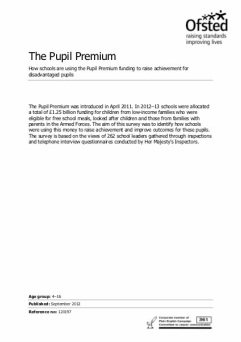The Pupil Premium is aimed at addressing the current underlying inequalities that continues to plague outcomes for pupils from disadvantaged backgrounds in England. When the Pupil Premium was introduced in April 2011 schools received an additional £488 for each of its pupils eligible for free school meals. In April 2012 this was increased to £600, and further increases this year have already been announced so that it is now worth £900, amounting to £1.65 billion in the financial year 2013-2014. By 2015 the Pupil Premium will be worth £2.5 billion of additional money coming into schools, which in these austere times is a considerable amount of money and if used effectively could close the gaps in attainment and go quite a way to transform many young people’s educational outcomes and life chances.
“Schools should continue to seek ways to encourage parents and carers to apply for free school meals where pride, stigma or changing circumstances act as barriers to its take-up”.
However, this important recommendation seemed to have got lost in the discussions and focus on how the pupil premium should be used to ensure maximum impact. In addition, although this report made this recommendation it did not actually identify how many pupils who were eligible for free school meals and were currently taking it up, which areas of England this may be an issue for nor the characteristics of the type of pupils who this may apply to. Therefore, a recent report published by the DfE has revealed some interesting information with regards to estimates and proportions of pupils not claiming free school meals even though they are entitled to it.
From their analysis they estimate that around 200,000 pupils which is 3% of all pupils aged between 4-15 years old in maintained schools are not claiming FSM even though they appear to be entitled. They derive this figure by comparing the number and percentage of pupils who are registered to claim FSM from the School Census data in 2011- 2012 which was 1.2 million pupils or 18% of 4-15 year old pupils against the benefits data from HMRC which suggests that around 1.4 million pupils or 21% of pupil
The report also highlights variations in the age profile of pupils claiming FSM with younger pupils more likely to be entitled to claim FSM compared to older pupils (25 % of 5 years olds compared to 18% of 15 year olds), with the proportion of those not claiming FSM being the same across both primary and secondary.
Interestingly, they also found wide variations across regions with the following LA’s showing full registration rates for FSM eligibility:
- Birmingham
- Bolton
- Darlington
- Halton
- Hartlepool
- Islington
- Middlesbrough
- Newham
- Plymouth
- Stockton-on-Tees
- Stoke-on-Trent
- Sunderland
- Tower Hamlets
- Wigan
In comparison, the following 10 LA’s had the highest non-registration rates:
- Bournemouth 29%
- Buckinghamshire 33%
- Richmond upon Thames 33%
- Suffolk 32%
- Surrey 32%
- Bath and North East Somerset 31%
- Bromley 30%
- Poole 30%
- Milton Keynes 30%
- Bracknell Forest 30%
The research report also provides a useful checklist of pupil characteristics, not directly linked to FSM but which lead to a lower likelihood of claiming FSM, after other characteristics have been taken into account. These are pupils:
- living in a less deprived area;
- attending schools with a lower school FSM rate;
- from families with higher status occupations (i.e. professional rather than routine occupations);
- living in a family with higher parental qualifications; and
- of Chinese ethnic origin.
They also point out that there is some evidence to suggest that families entitled to FSM while in some part-time work are less likely to claim FSM than those on out-of-work benefits.
Ofsted in its report, last September stated that:
“The average amount of Pupil Premium funding received by all schools nationally in 2011–12 was £30,940 and the median was £19,520.[1] An average-sized secondary school with the average proportion of pupils eligible for free school meals would have received around £77,000. An average-sized primary school with the average proportion of pupils eligible for free school meals would have received around £23,000. The average amount of Pupil Premium funding received by the schools who answered additional questions on HMI-led inspections was £49,056, and the median was £38,052.”
Bearing in mind the increased figures for this year and forthcoming years involved in the Pupil Premium, schools and LA are advised to read this valuable DfE report, consider the implications for their area and develop a strategy based on their analysis and need, to ensure that all the pupils who are eligible for free school meals are actually benefiting from it and more importantly that this resource is used so that it has maximum impact for these pupils. Colleagues may wish to read an earlier post Effective classroom strategies for closing the gap in educational achievement for children and young people living in poverty, including white working-class boys on this blog, as well as read future blogs which will focus on this area.



 RSS Feed
RSS Feed
